For many dog lovers, the idea of a furry companion is delightful until thoughts turn to shedding, dander, and potential allergies. While dogs are cherished members of families worldwide, the reality of pet hair coating furniture and triggering sneezes can be a significant deterrent. The good news is that numerous dog breeds are renowned for their minimal shedding, offering a cleaner home environment and often, a more comfortable experience for allergy sufferers.
This comprehensive guide explores the fascinating world of dogs who don’t shed a lot, diving into what makes these breeds unique and providing an in-depth look at some of the best choices for those seeking a low-maintenance coat.
Understanding Low-Shedding vs. Hypoallergenic
It’s a common misconception that “low-shedding” automatically means “hypoallergenic.” While these terms are often used interchangeably, there’s a crucial distinction. All dogs produce allergens, primarily from their dander (flakes of dead skin), saliva, and urine, not just their hair. However, dogs who don’t shed a lot tend to release less dander into the environment simply because they lose less hair. Less hair turnover means fewer airborne allergens, making them a better fit for individuals with mild dog allergies.
It’s important to remember that no dog is 100% allergen-free. Even breeds with minimal shedding can still trigger allergic reactions in sensitive individuals due to the allergens present in their skin, saliva, and urine. The goal with low-shedding breeds is to significantly reduce exposure to these triggers, providing a more manageable living situation. For a broader understanding of different breeds, check out our guide on low-shedding dog breeds.
Top Dog Breeds Who Don’t Shed a Lot
Choosing a dog who doesn’t shed a lot can make a significant difference in your home’s cleanliness and your family’s comfort. Here’s a detailed look at some of the most popular and suitable breeds:
1. Poodle (Standard, Miniature, Toy)
 Elegant white Poodle gracefully walking in green grass, a popular choice among dogs who don't shed a lot.
Elegant white Poodle gracefully walking in green grass, a popular choice among dogs who don't shed a lot.
Poodles are perhaps the most famous of all low-shedding dogs. Available in three sizes—Standard, Miniature, and Toy—they are known for their distinctive curly coats that shed very little. This coat type traps loose hair and dander, preventing it from spreading throughout your home. Beyond their minimal shedding, Poodles are highly intelligent, eager to please, and excel in obedience and agility. Their active nature requires regular exercise and mental stimulation. Despite their non-shedding quality, Poodles require consistent grooming to prevent their dense curls from matting. This includes frequent brushing and professional clipping every 4-6 weeks.
2. Yorkshire Terrier
 Charming blue and tan Yorkie lounging on an armchair, a small dog who doesn't shed much.
Charming blue and tan Yorkie lounging on an armchair, a small dog who doesn't shed much.
These tiny titans possess a long, silky coat that is remarkably low-shedding. Yorkies are known for their spunky, confident, and affectionate personalities, making them excellent companions. They adapt well to various living environments, from spacious houses to compact apartments, as long as they receive ample attention and playtime. Despite their small stature, Yorkies are spirited and enjoy daily walks and indoor games. Their fine hair, similar to human hair, needs daily brushing to prevent tangles and regular trimming to maintain its length and health.
3. Shih Tzu
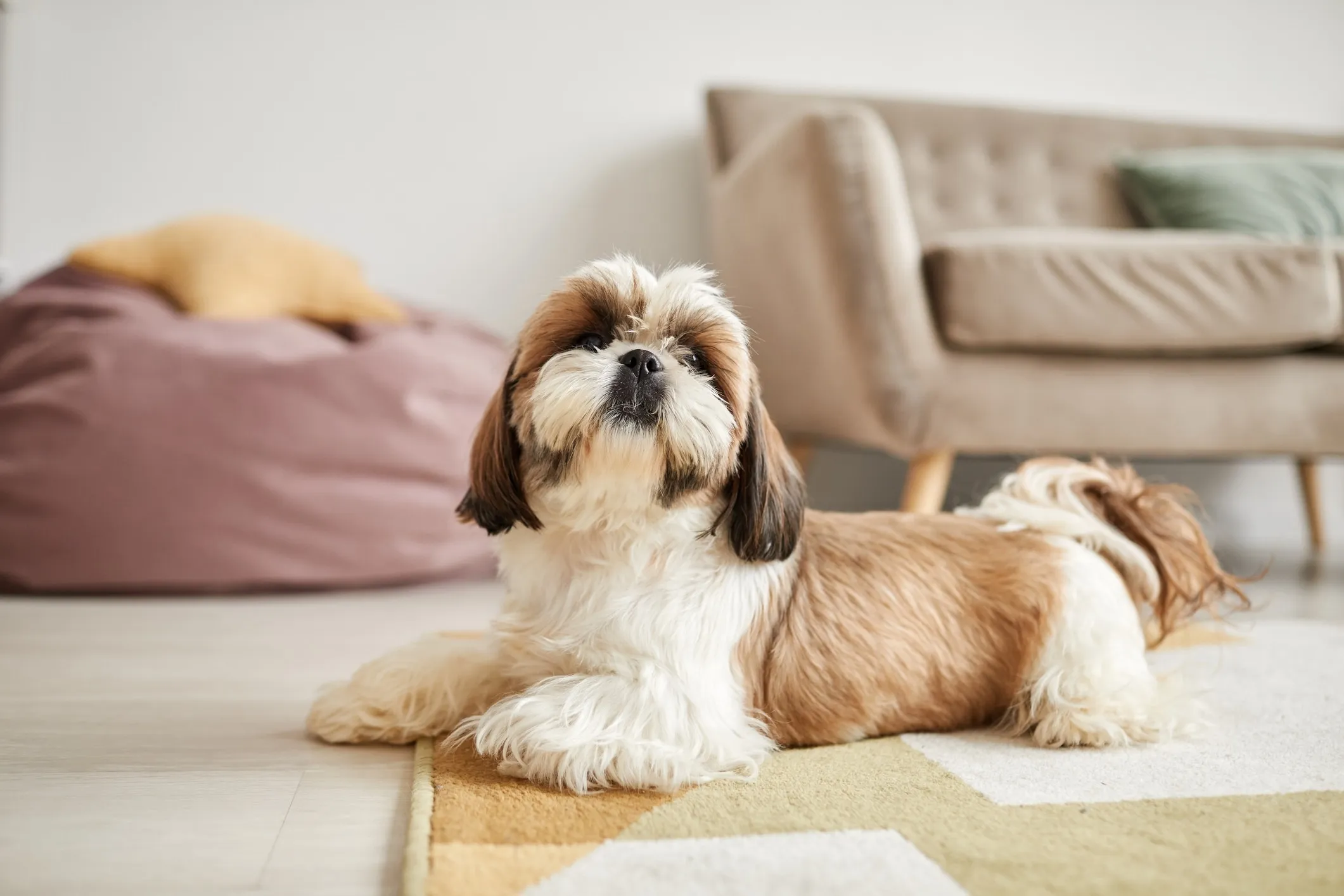 Adorable brown and white Shih Tzu lying on a living room floor, a friendly breed among dogs who don't shed a lot.
Adorable brown and white Shih Tzu lying on a living room floor, a friendly breed among dogs who don't shed a lot.
The Shih Tzu is an ancient companion breed celebrated for its luxurious, flowing coat and friendly disposition. These small dogs are known for their loving and outgoing nature, thriving on human companionship. Their long hair sheds minimally but requires significant grooming to keep it healthy and free of mats. This includes daily brushing and regular professional grooming. Shih Tzus, due to their brachycephalic (flat) faces, can be susceptible to health issues like overheating and breathing problems, so care must be taken in hot weather. They also often develop tear stains that need regular cleaning.
4. Miniature Schnauzer
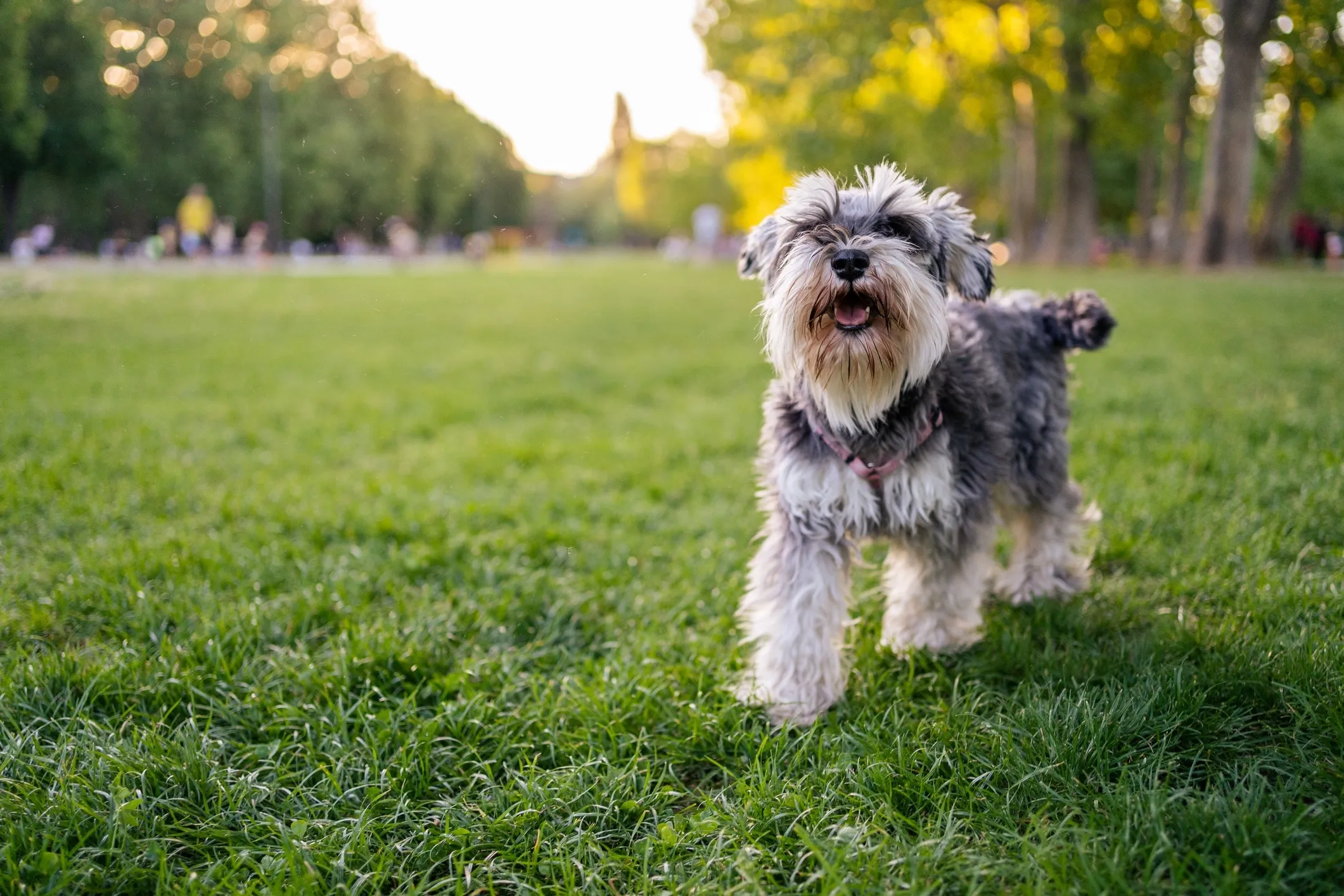 Alert salt and pepper Miniature Schnauzer wearing a pink harness in a park, a smart choice for those seeking dogs who don't shed a lot.
Alert salt and pepper Miniature Schnauzer wearing a pink harness in a park, a smart choice for those seeking dogs who don't shed a lot.
Miniature Schnauzers are robust and intelligent dogs with a distinctive wiry coat that sheds very little. Standing no more than 14 inches tall, they are versatile companions well-suited for various living situations. These spirited dogs require at least an hour of exercise daily to keep them happy and well-behaved, enjoying activities like brisk walks and playtime. Their coat needs regular stripping or clipping to maintain its texture and minimize shedding, along with weekly brushing.
5. Standard Schnauzer
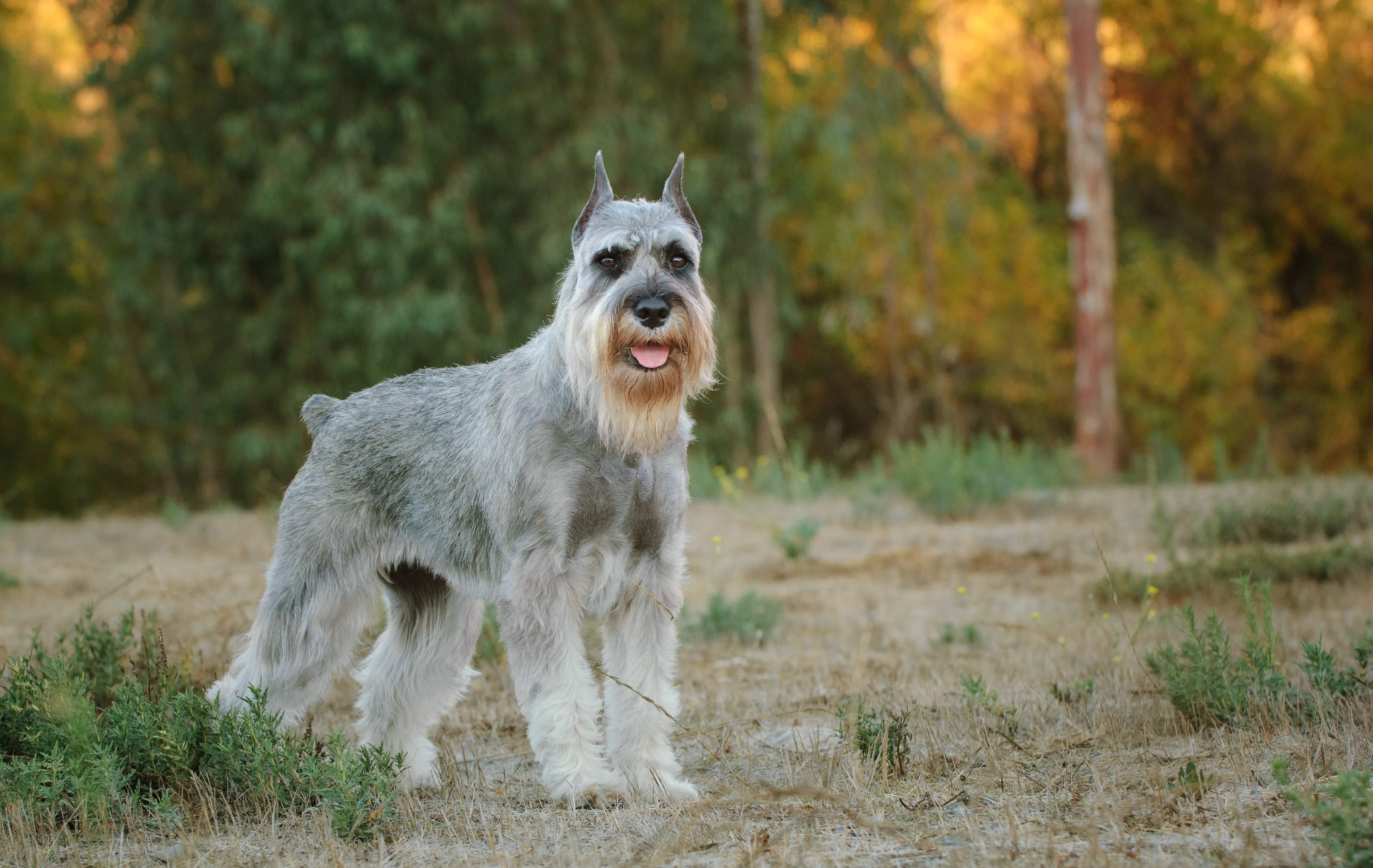 Dignified gray Standard Schnauzer standing in a field, an example of medium sized dogs that don't shed a lot.
Dignified gray Standard Schnauzer standing in a field, an example of medium sized dogs that don't shed a lot.
Sharing many excellent qualities with their smaller counterparts, Standard Schnauzers offer a larger package while still being low-shedding. These intelligent and protective dogs can weigh up to 45 pounds and thrive on activity. They love long walks, interactive games like fetch, and solving puzzle toys. Their wiry, dense coat also needs regular grooming, including hand-stripping or professional clipping, to maintain its health and low-shedding properties. They are among the popular medium-sized dogs that don’t shed much.
6. Giant Schnauzer
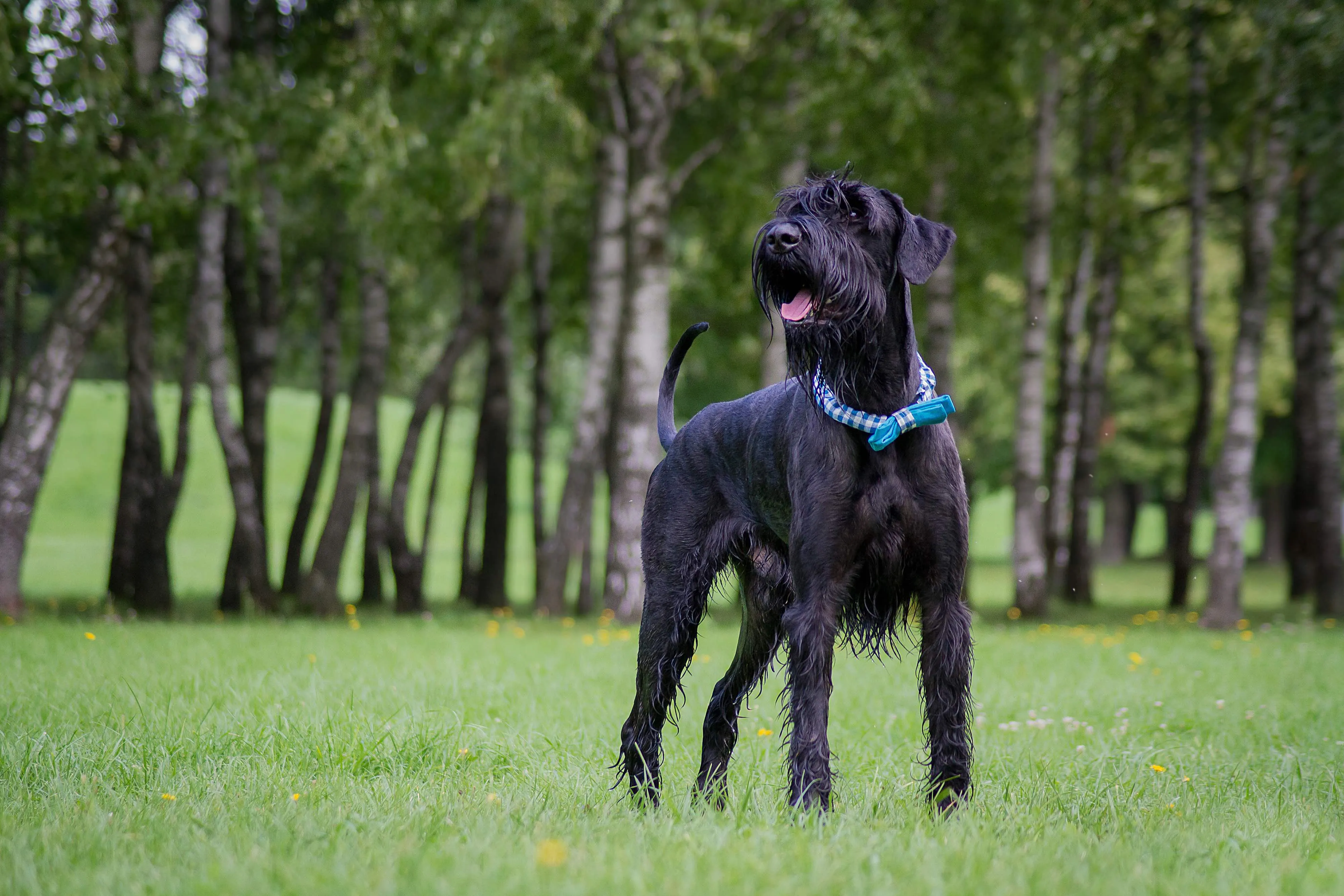 Powerful black wet Giant Schnauzer wearing a blue bow collar standing in a park, a large dog that doesn't shed a lot.
Powerful black wet Giant Schnauzer wearing a blue bow collar standing in a park, a large dog that doesn't shed a lot.
For those who desire a larger, low-shedding companion, the Giant Schnauzer is an excellent choice. Reaching over 27 inches tall and weighing up to 85 pounds, these dogs are imposing yet loyal. They are highly energetic and require extensive daily exercise, such as long walks, runs, hikes, and active playtime, to prevent boredom and destructive behaviors. Their coarse, wiry coat demands consistent grooming to prevent matting and maintain its minimal shedding characteristics. If you’re looking for large dogs that don’t shed, this breed is a strong contender.
7. Bichon Frise
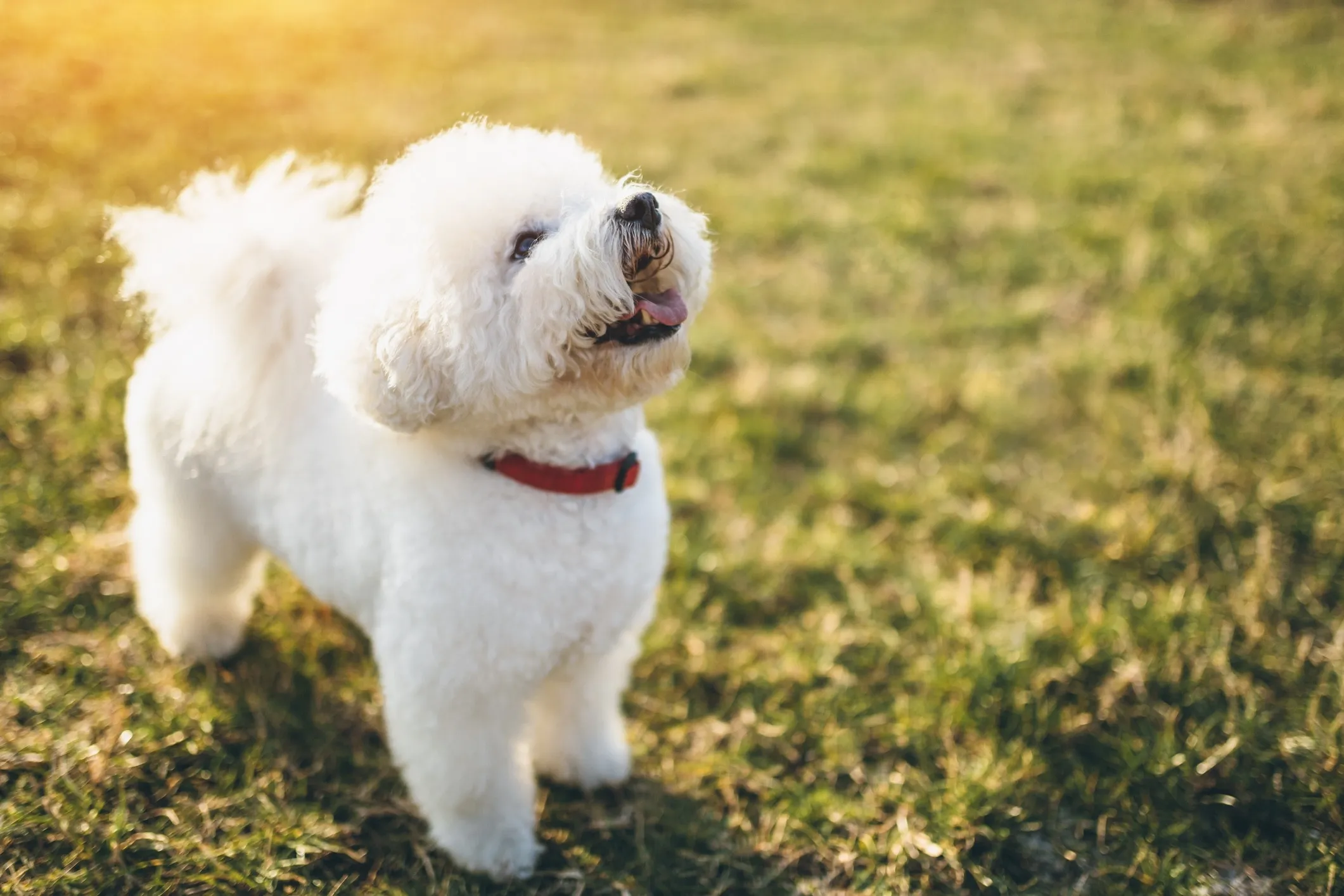 Playful white Bichon Frise dog looking up in the grass, a small, curly-coated breed among dogs who don't shed a lot.
Playful white Bichon Frise dog looking up in the grass, a small, curly-coated breed among dogs who don't shed a lot.
Small, cheerful, and affectionate, the Bichon Frise boasts a powder-puff-like double coat that sheds very little. They are intelligent and highly trainable, quickly picking up basic commands and even fun tricks with positive reinforcement. Bichons thrive on companionship and are generally good with children and other pets. Their fluffy coat requires daily brushing and regular professional grooming to prevent matting and keep them looking their best.
8. Chinese Crested
 Unique black hairless Chinese Crested dog looking at the camera, a distinctive low-shedding breed.
Unique black hairless Chinese Crested dog looking at the camera, a distinctive low-shedding breed.
The Chinese Crested is known for its distinctive appearance and comes in two varieties: Hairless and Powderpuff. Both are considered low-shedding. The Hairless variety has smooth skin with tufts of hair on its head, tail, and paws, while the Powderpuff is covered in a soft, silky coat. Both are playful, affectionate, and make wonderful companions. The Hairless needs skin care (sunscreen, moisturizing) while the Powderpuff needs regular brushing to prevent matting.
9. Portuguese Water Dog
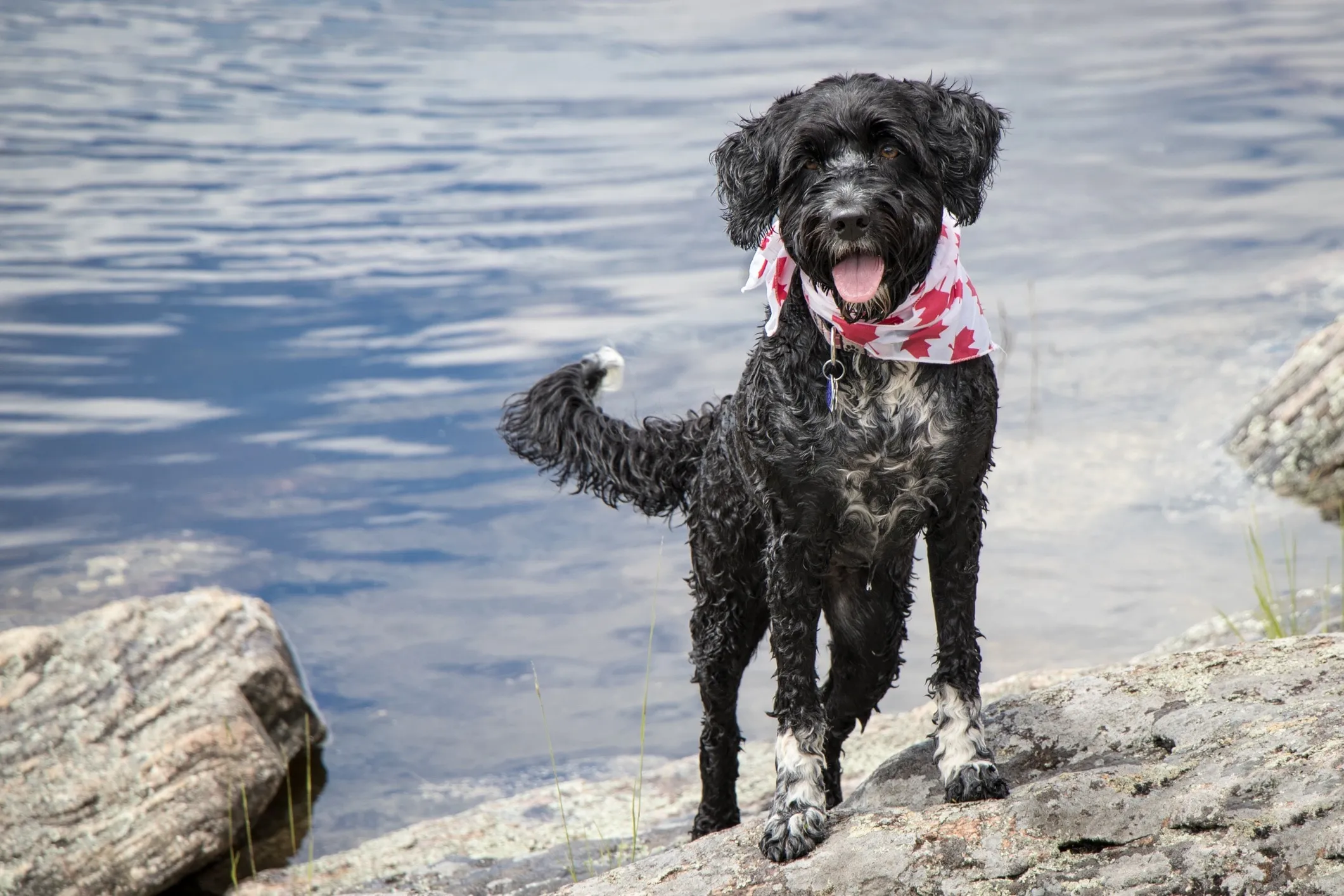 Alert black and white Portuguese Water Dog wearing a red maple leaf bandana in front of water, an active breed of dogs that don't shed a lot.
Alert black and white Portuguese Water Dog wearing a red maple leaf bandana in front of water, an active breed of dogs that don't shed a lot.
Originally bred to assist fishermen, Portuguese Water Dogs are intelligent, highly trainable, and energetic. Their thick, curly, single coat sheds minimally, making them a popular choice for those concerned about hair. These medium-sized dogs thrive on regular exercise, especially activities involving water, like swimming and retrieving floating toys. Their robust coat requires consistent grooming, including brushing several times a week and professional clipping every 6-8 weeks, to prevent matting. This is another excellent choice among medium dogs that rarely shed.
10. Labradoodle
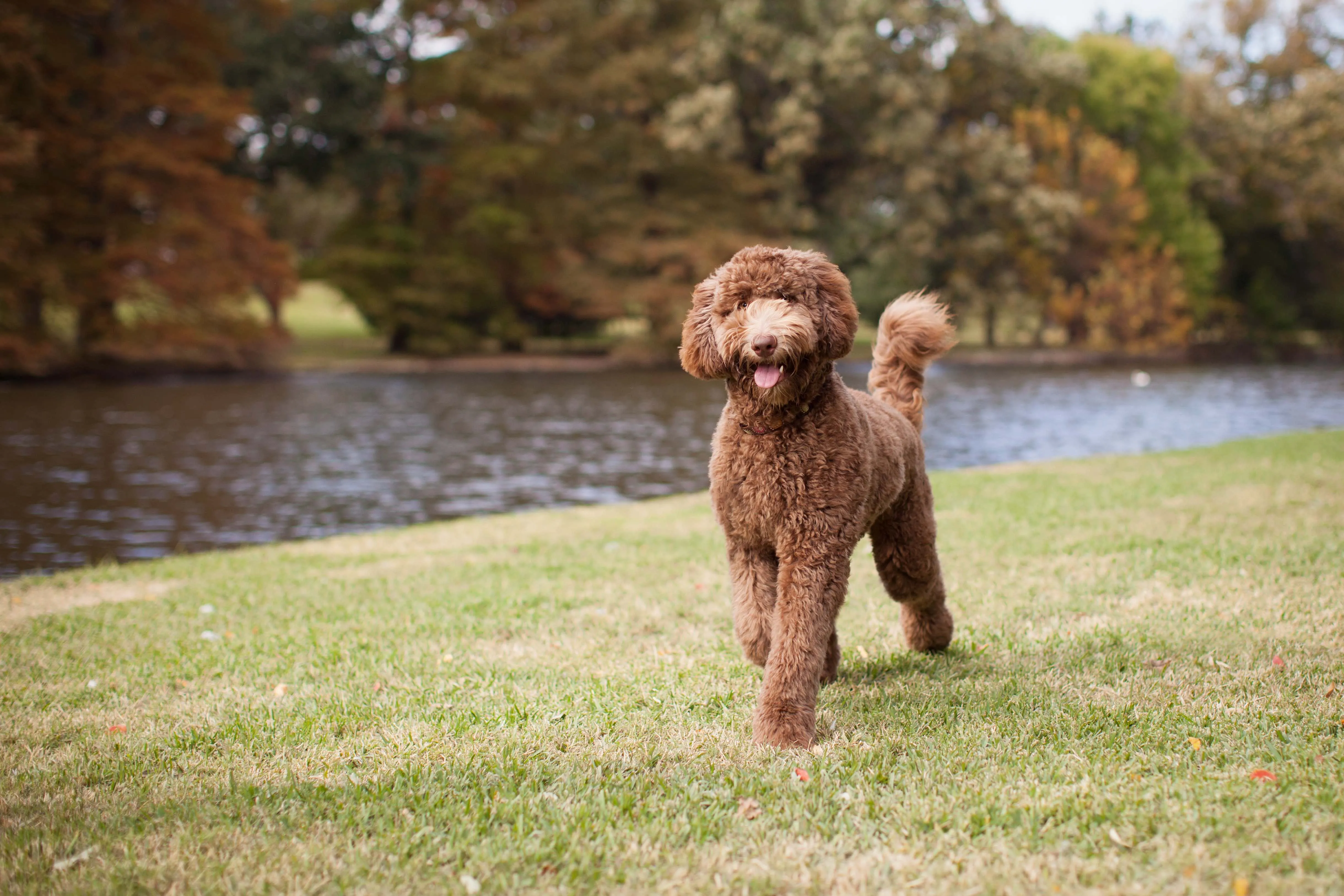 Friendly brown Standard Labradoodle walking in a park, a popular crossbreed that doesn't shed much.
Friendly brown Standard Labradoodle walking in a park, a popular crossbreed that doesn't shed much.
A cross between a Labrador Retriever and a Poodle, the Labradoodle was originally bred to be a low-allergen service dog. They are intelligent, friendly, and make wonderful family pets. Labradoodles are highly trainable and gentle, especially when well-exercised and socialized from an early age. Their coats can vary from wavy to curly, and while most shed minimally, some may shed more depending on their Poodle-to-Labrador genetic ratio. Regular brushing and professional grooming are essential to maintain their coat.
11. Goldendoodle
 Affectionate Goldendoodle lying on a couch with a person sitting in the background, a popular choice among dogs who don't shed a lot.
Affectionate Goldendoodle lying on a couch with a person sitting in the background, a popular choice among dogs who don't shed a lot.
Another popular “doodle” breed, Goldendoodles are a cross between a Golden Retriever and a Poodle. Like Labradoodles, they are known for their minimal shedding, friendly nature, and high intelligence. Their coats come in a variety of colors and textures, from wavy to curly. They require frequent grooming with a slicker brush to prevent matting, as their soft, fluffy coats can tangle easily. Goldendoodles are excellent family dogs, known for their patient and sociable personalities.
12. Lagotto Romagnolo
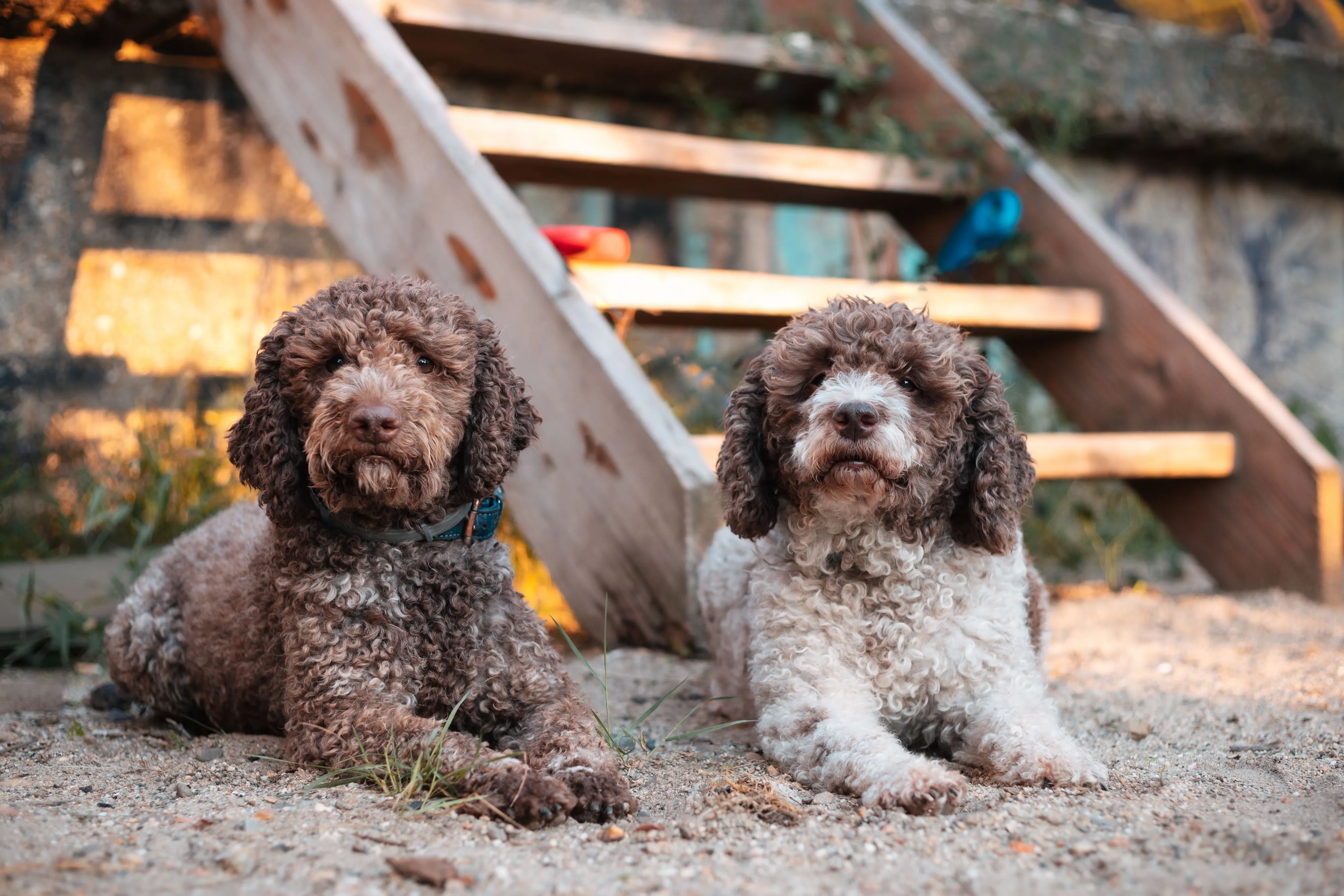 Intrigued two Lagotto Romagnolo dogs lying in dirt staring at the camera, a lesser-known breed of dogs who don't shed a lot.
Intrigued two Lagotto Romagnolo dogs lying in dirt staring at the camera, a lesser-known breed of dogs who don't shed a lot.
Originally Italian water retrievers, Lagotto Romagnolo dogs possess a thick, curly, woolly coat that protected them from cold waters and sheds very little. While less common than some other low-shedding breeds, Lagotti Romagnoli are known for being good with children and other pets, making them excellent family dogs. Their dense, non-shedding coat requires regular clipping and brushing to keep it tidy and prevent mats.
13. Affenpinscher
 Expressive black Affenpinscher dog close-up, a small breed with a wiry coat that doesn't shed much.
Expressive black Affenpinscher dog close-up, a small breed with a wiry coat that doesn't shed much.
Affenpinschers are small dogs often described as “monkey-like” in appearance. Their dense, wiry coat produces fewer allergens and sheds minimally compared to many other breeds. However, this unique coat requires a specific grooming routine, including at-home brushing and professional hand-stripping rather than simple trimming, to maintain its texture and low-shedding quality. They are curious, playful, and loyal companions.
14. Irish Water Spaniel
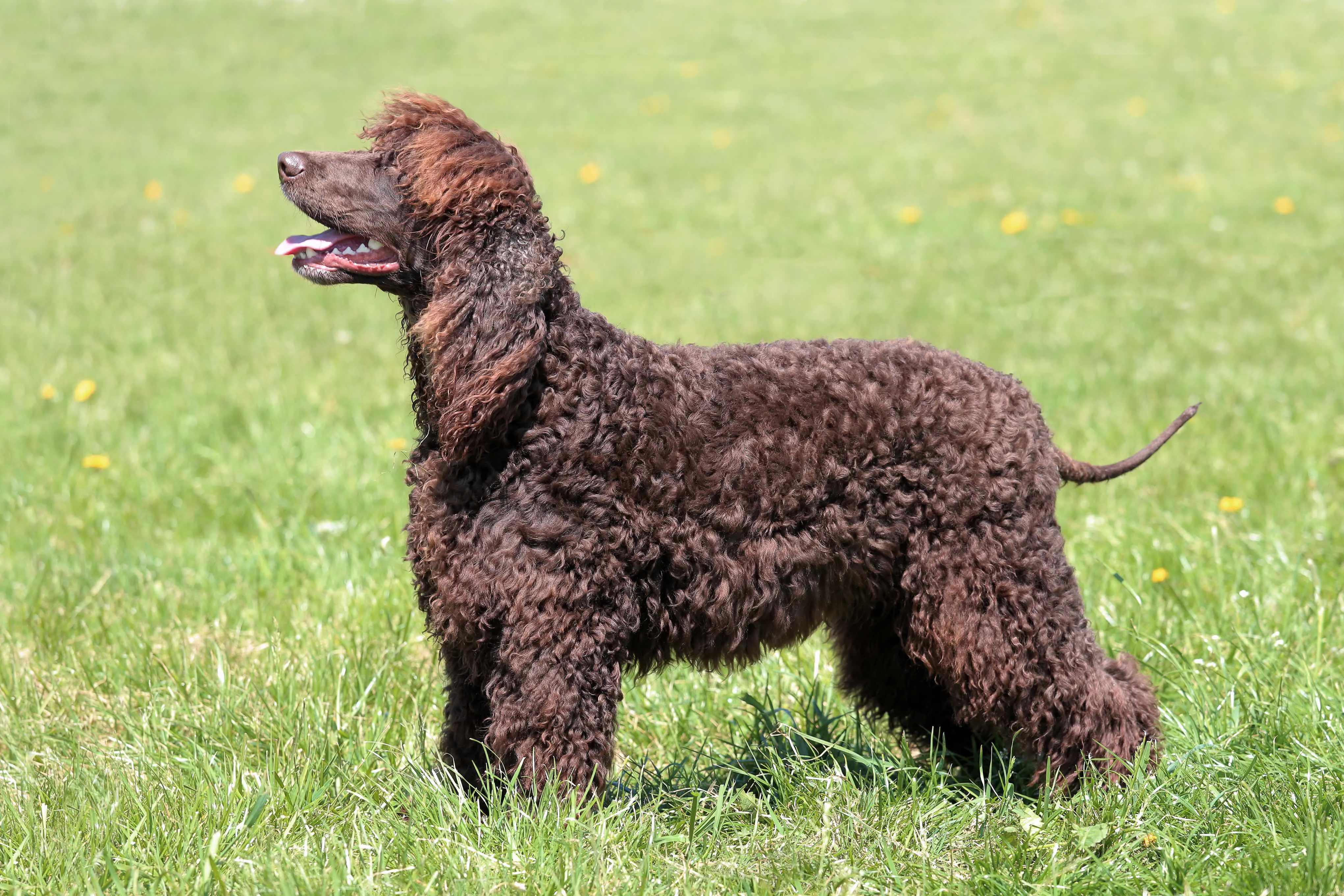 Distinguished brown Irish Water Spaniel in profile, a high-energy dog who doesn't shed a lot.
Distinguished brown Irish Water Spaniel in profile, a high-energy dog who doesn't shed a lot.
Friendly, intelligent, and highly trainable, Irish Water Spaniels are another water-loving breed with a thick, curly coat that sheds very little. Their distinctive liver-colored coat requires regular grooming, including brushing and occasional trimming, to keep it healthy. These high-energy dogs need plenty of exercise to stay happy and prevent boredom, making them ideal for active families.
15. Aussiedoodle
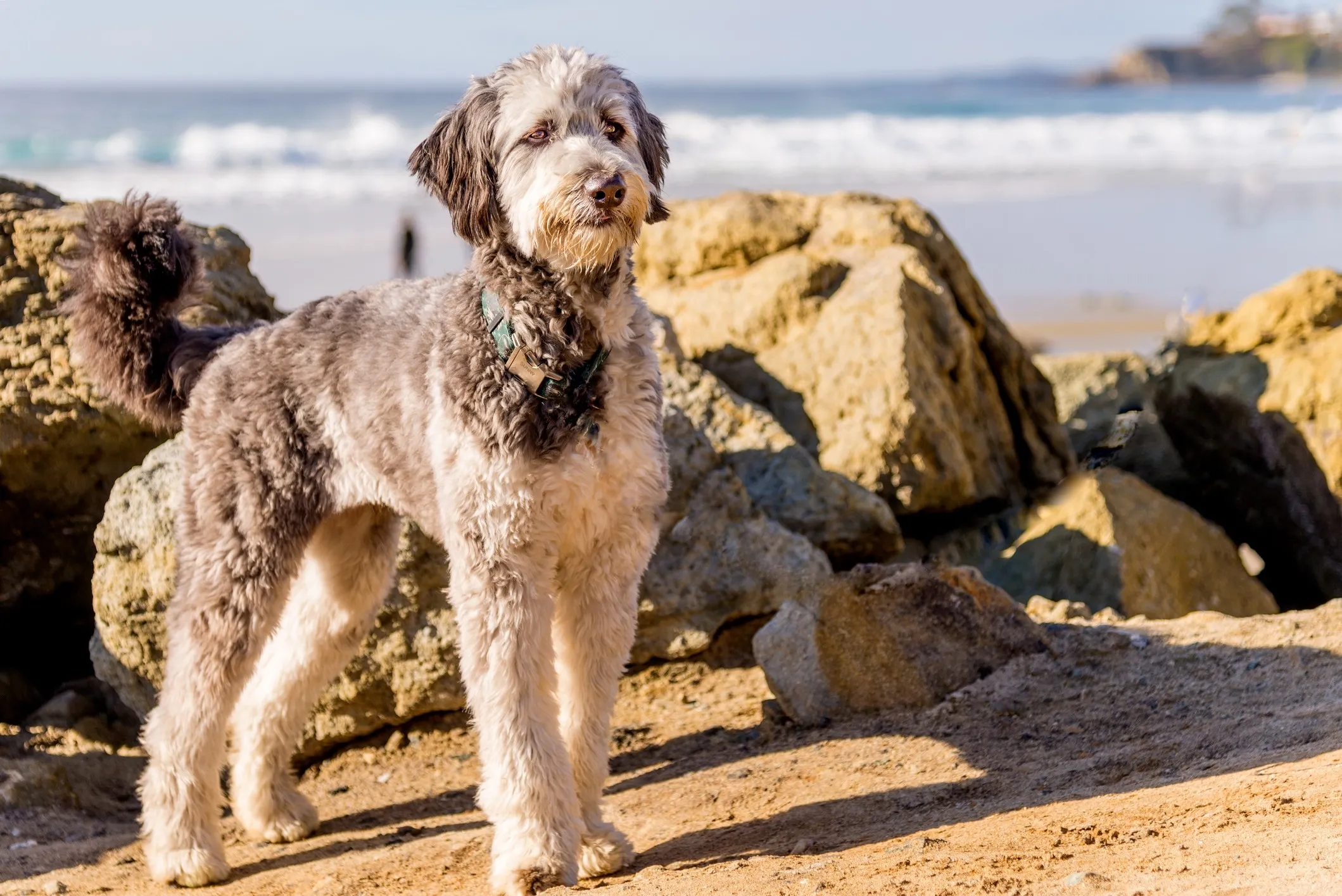 Majestic Standard Aussiedoodle dog standing on a beach, a smart and energetic choice among dogs who don't shed a lot.
Majestic Standard Aussiedoodle dog standing on a beach, a smart and energetic choice among dogs who don't shed a lot.
The Aussiedoodle is a cross between an Australian Shepherd and a Poodle, inheriting intelligence and high energy from both parent breeds. This low-shedding dog is very smart and thrives on activity and mental stimulation. Without sufficient exercise and enrichment, they can become bored and destructive. Their coat can be wavy or curly and requires regular brushing and grooming to prevent tangles and mats.
16. Bolognese
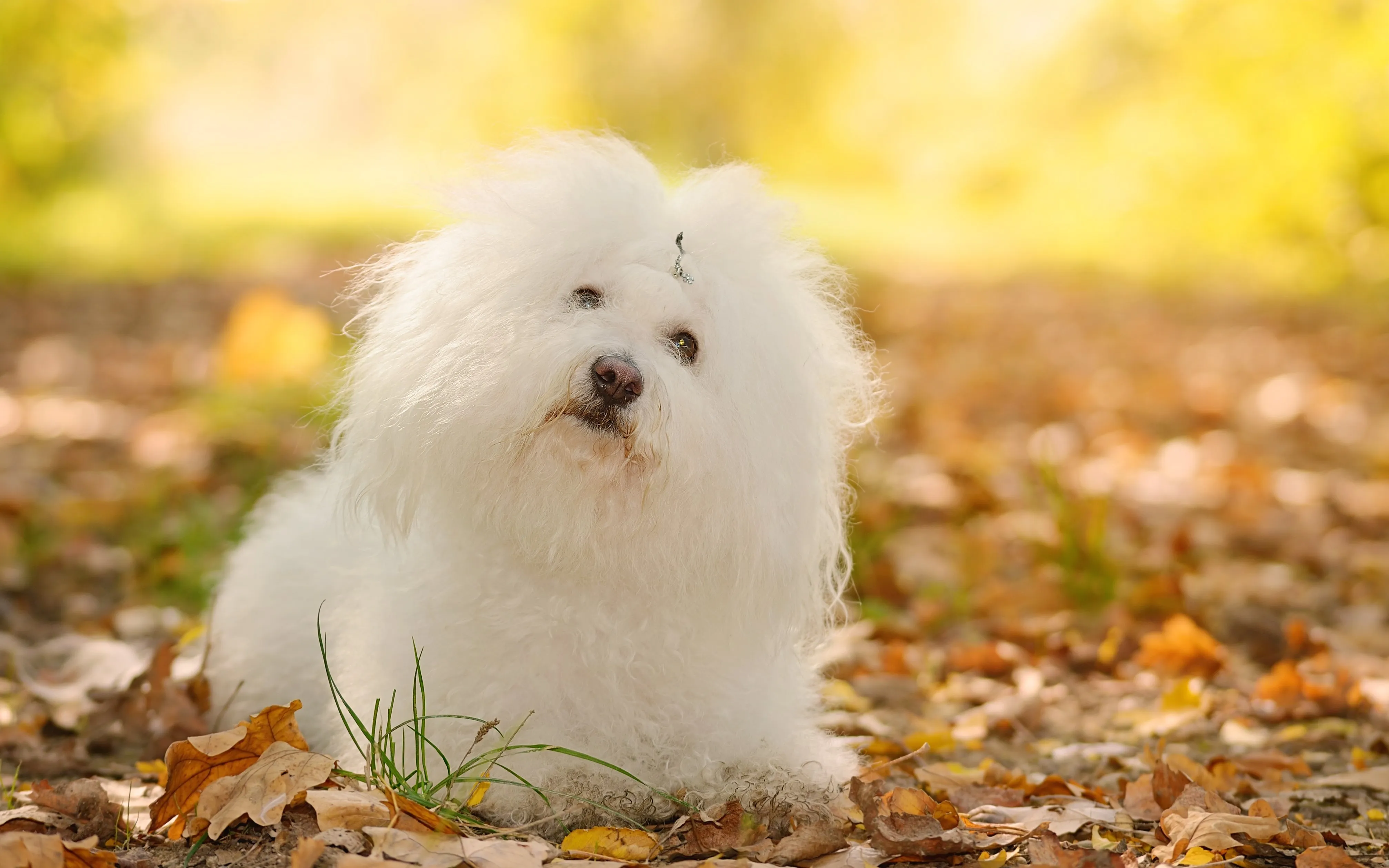 Fluffy white Bolognese dog sitting in an autumn forest, a charming small breed that doesn't shed much.
Fluffy white Bolognese dog sitting in an autumn forest, a charming small breed that doesn't shed much.
Originating in Italy, Bolognese dogs are cute, playful, and easygoing. They possess a long, fluffy white coat that, despite its somewhat messy appearance, sheds minimally. This characteristic coat demands regular grooming, including daily brushing, to prevent matting. Bolognese are known for their friendly demeanor, getting along well with children and other pets, and fitting comfortably into various living situations.
17. Maltese
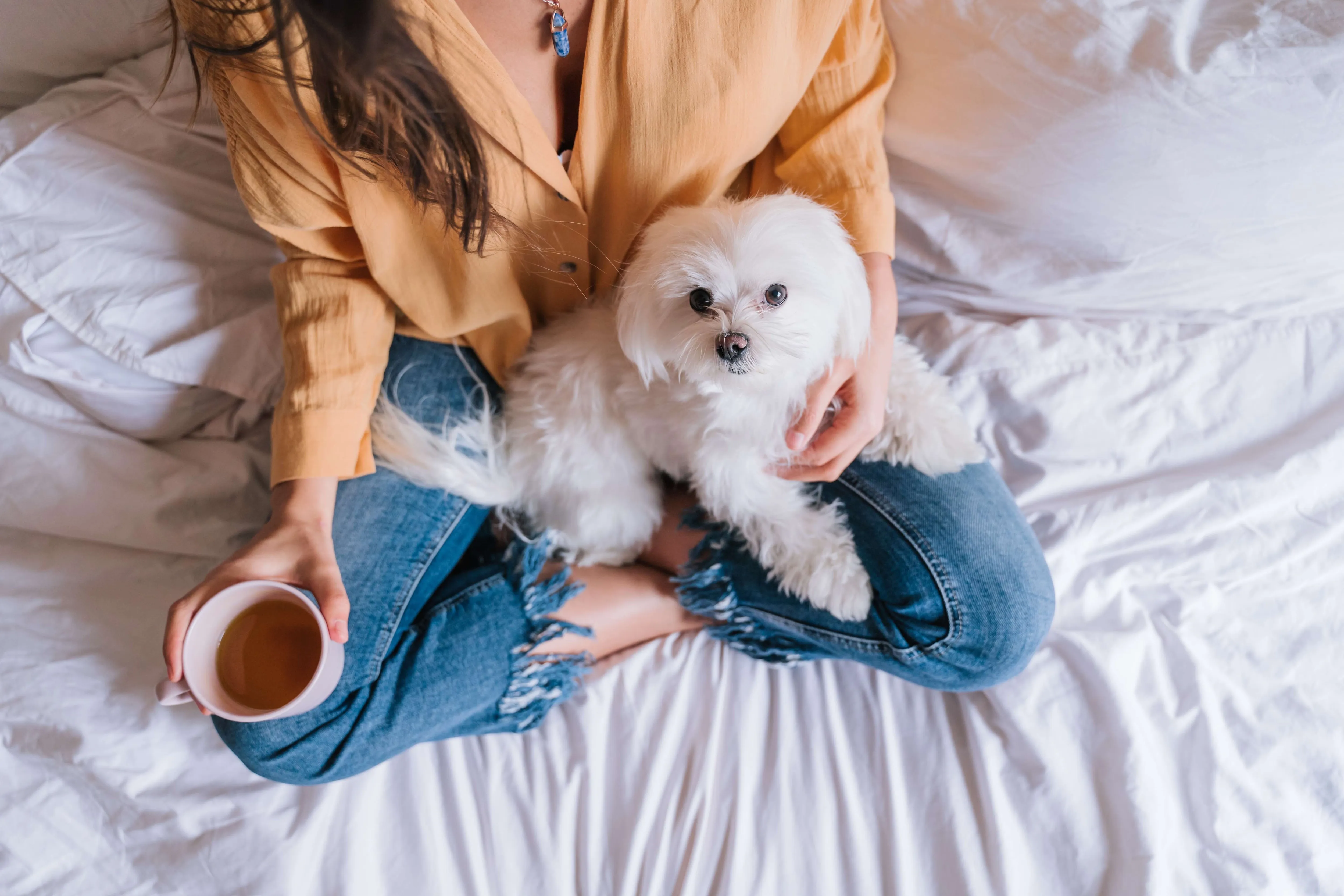 Woman gently holding a fluffy white Maltese dog on a bed, highlighting its luxurious, low-shedding coat.
Woman gently holding a fluffy white Maltese dog on a bed, highlighting its luxurious, low-shedding coat.
The Maltese is a small, elegant dog known for its luxurious, silky white coat that sheds very little. These affectionate and playful companions thrive on human interaction and are relatively easy to train. Their long coat requires consistent daily brushing to prevent tangles and mats. Many Maltese owners opt for a shorter “puppy cut” to simplify grooming, but either way, their beautiful hair demands dedication. This breed is a prime example of dogs with minimal hair shedding.
18. Soft Coated Wheaten Terrier
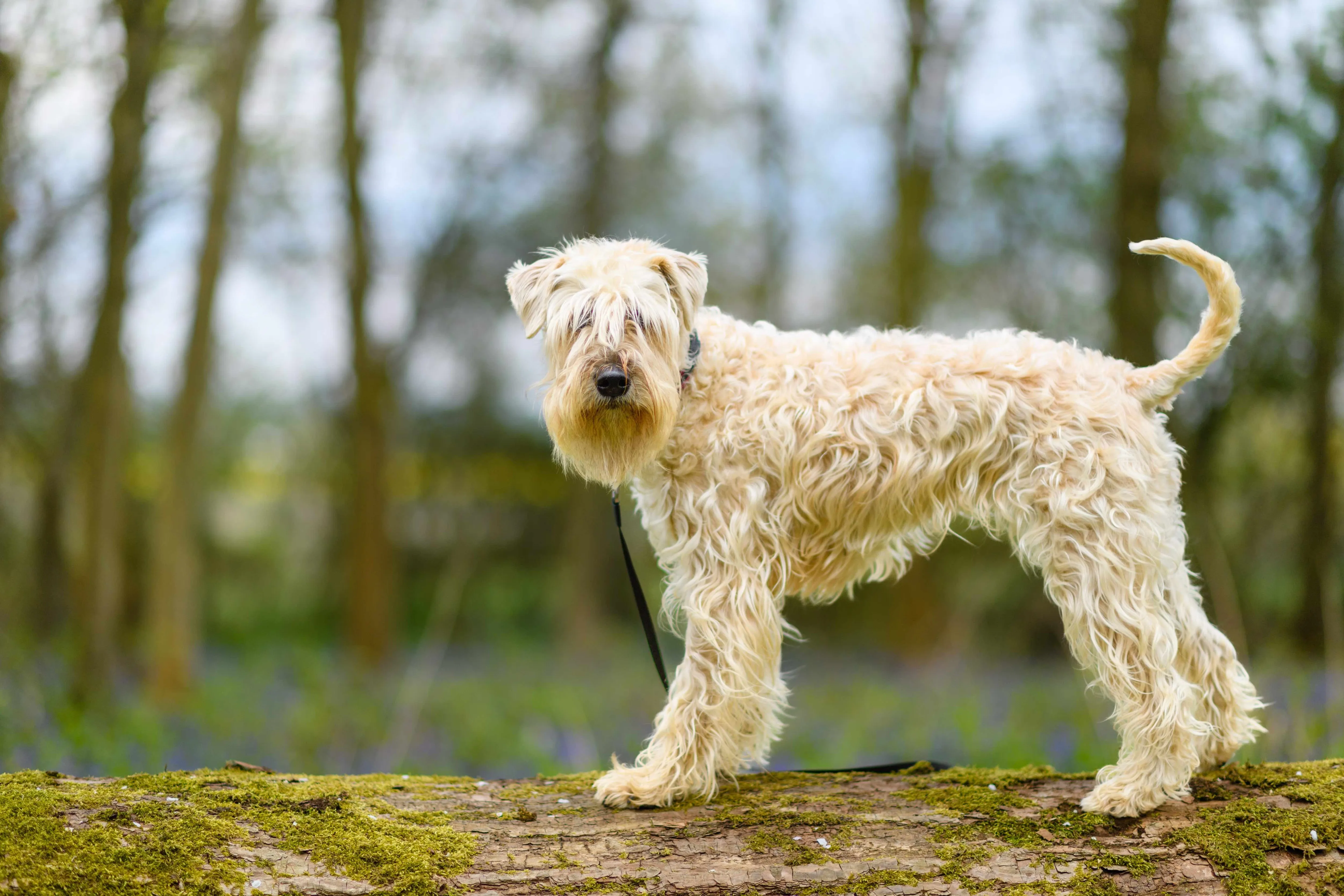 Joyful Soft Coated Wheaten Terrier dog on a log, showcasing its soft, non-shedding coat.
Joyful Soft Coated Wheaten Terrier dog on a log, showcasing its soft, non-shedding coat.
As their name suggests, Soft Coated Wheaten Terriers have an incredibly soft, silky coat that is wheat-colored and sheds minimally. This medium-sized Irish breed maintains a high energy level throughout its life, needing ample exercise and mental stimulation to be well-behaved and happy. Their single coat requires daily brushing and regular trimming to prevent matting, especially after active play.
19. Coton de Tulear
 Elegant white Coton de Tulear sitting in grass with hair blowing in the wind, a small, gentle dog who doesn't shed a lot.
Elegant white Coton de Tulear sitting in grass with hair blowing in the wind, a small, gentle dog who doesn't shed a lot.
Originating in Madagascar, the Coton de Tulear is a small, easygoing breed known for its soft, cotton-like coat that sheds very little. These charming dogs are adaptable, friendly, and generally good with children and other pets, especially with proper introductions. Their unique coat requires consistent brushing to prevent tangles and mats, along with periodic professional grooming.
20. Schnoodle
 Sweet gray Schnoodle close-up, a mixed breed combining two low-shedding dog parents.
Sweet gray Schnoodle close-up, a mixed breed combining two low-shedding dog parents.
The Schnoodle is a delightful cross between a Schnauzer and a Poodle, bringing together two inherently low-shedding breeds. Their coat can be curly or wavy, depending on which parent’s genes are more dominant, but it is consistently low-shedding. Schnoodles are intelligent, playful, and generally good-natured, making them excellent family pets. Regular brushing and professional grooming are necessary to keep their coats free of mats.
21. Bedlington Terrier
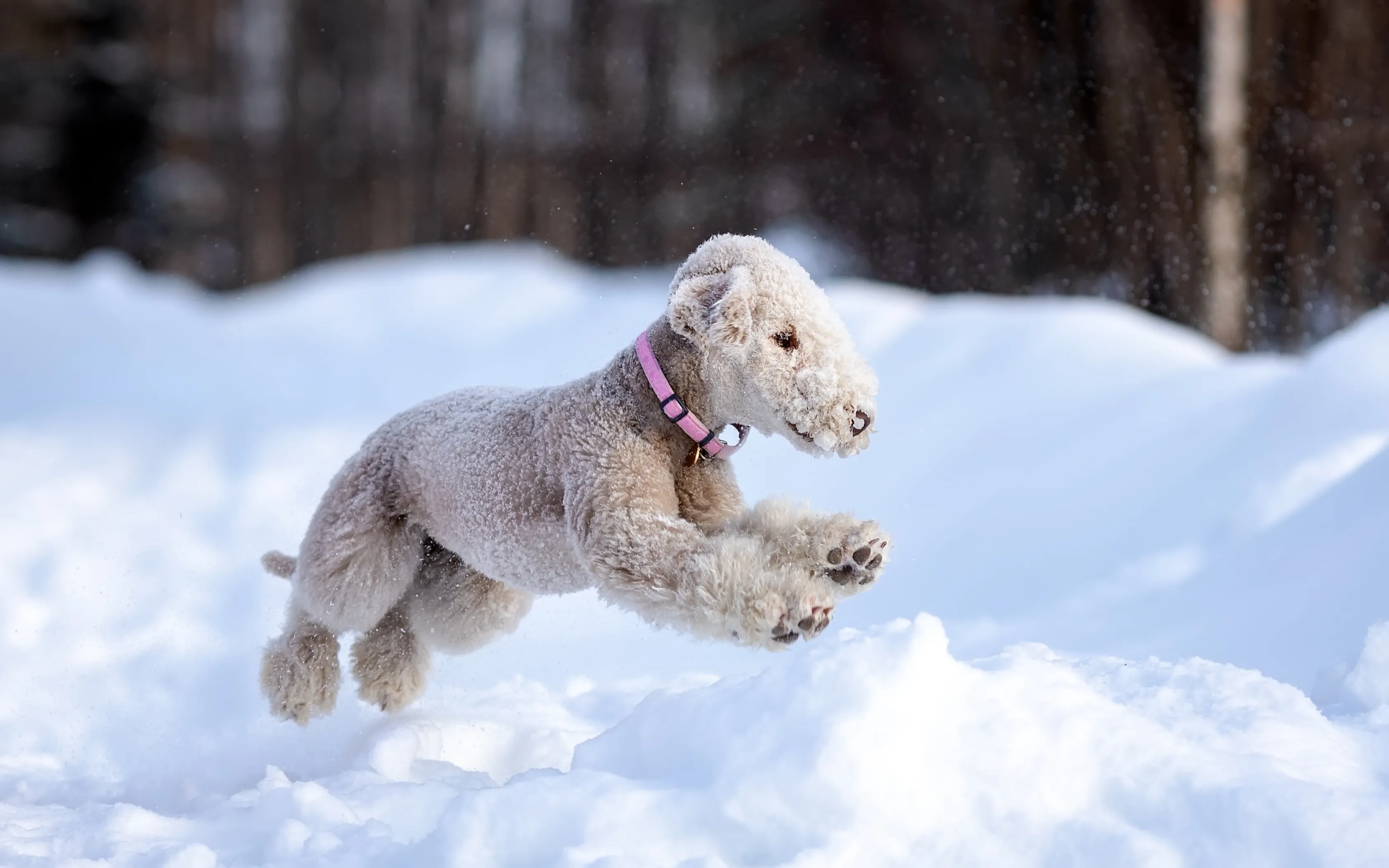 Athletic white Bedlington Terrier running through snow, known for its lamb-like appearance and minimal shedding.
Athletic white Bedlington Terrier running through snow, known for its lamb-like appearance and minimal shedding.
Often described as “a lamb in dog’s clothing,” the Bedlington Terrier is a distinctive small, curly-haired breed. Their unique woolly coat sheds very little. These dogs are affectionate and love being close to their people, often prone to separation anxiety if left alone for extended periods. Their coat requires regular professional grooming, including scissoring and hand-stripping, to maintain its iconic look and texture.
22. Xoloitzcuintli (Mexican Hairless Dog)
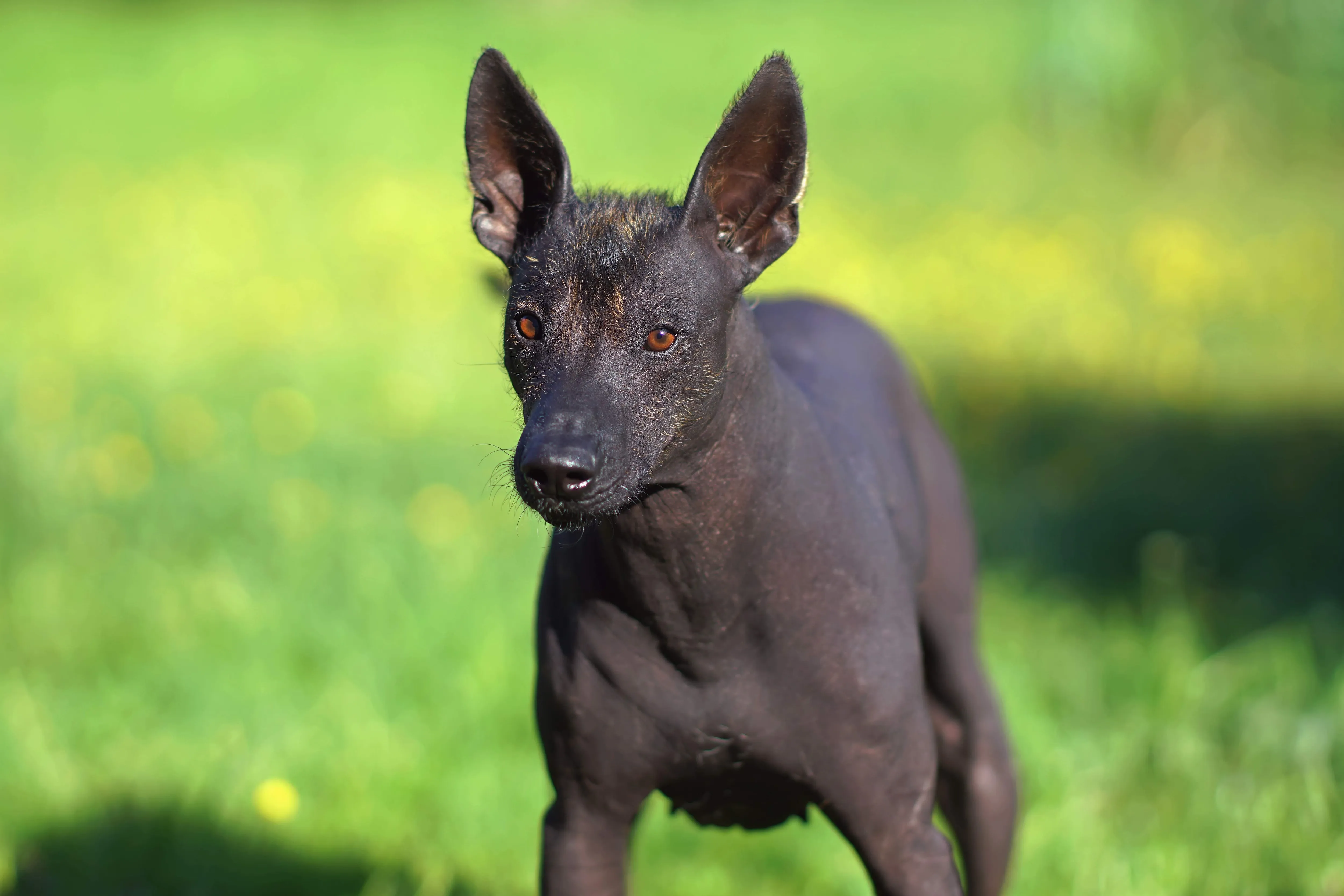 Majestic black Mexican Hairless Dog (Xoloitzcuintli) standing in grass, a truly low-shedding ancient breed.
Majestic black Mexican Hairless Dog (Xoloitzcuintli) standing in grass, a truly low-shedding ancient breed.
The Xoloitzcuintli, or Mexican Hairless Dog, is one of the oldest and rarest breeds, primarily known for its hairless variety, which naturally sheds nothing. There is also a coated variety with a short, smooth coat that also sheds minimally. Available in three sizes (toy, miniature, and standard), Xolos are calm, watchful, and loyal companions. The hairless variety requires skin care, including moisturizing and sun protection, while the coated variety needs occasional brushing.
23. Whoodle
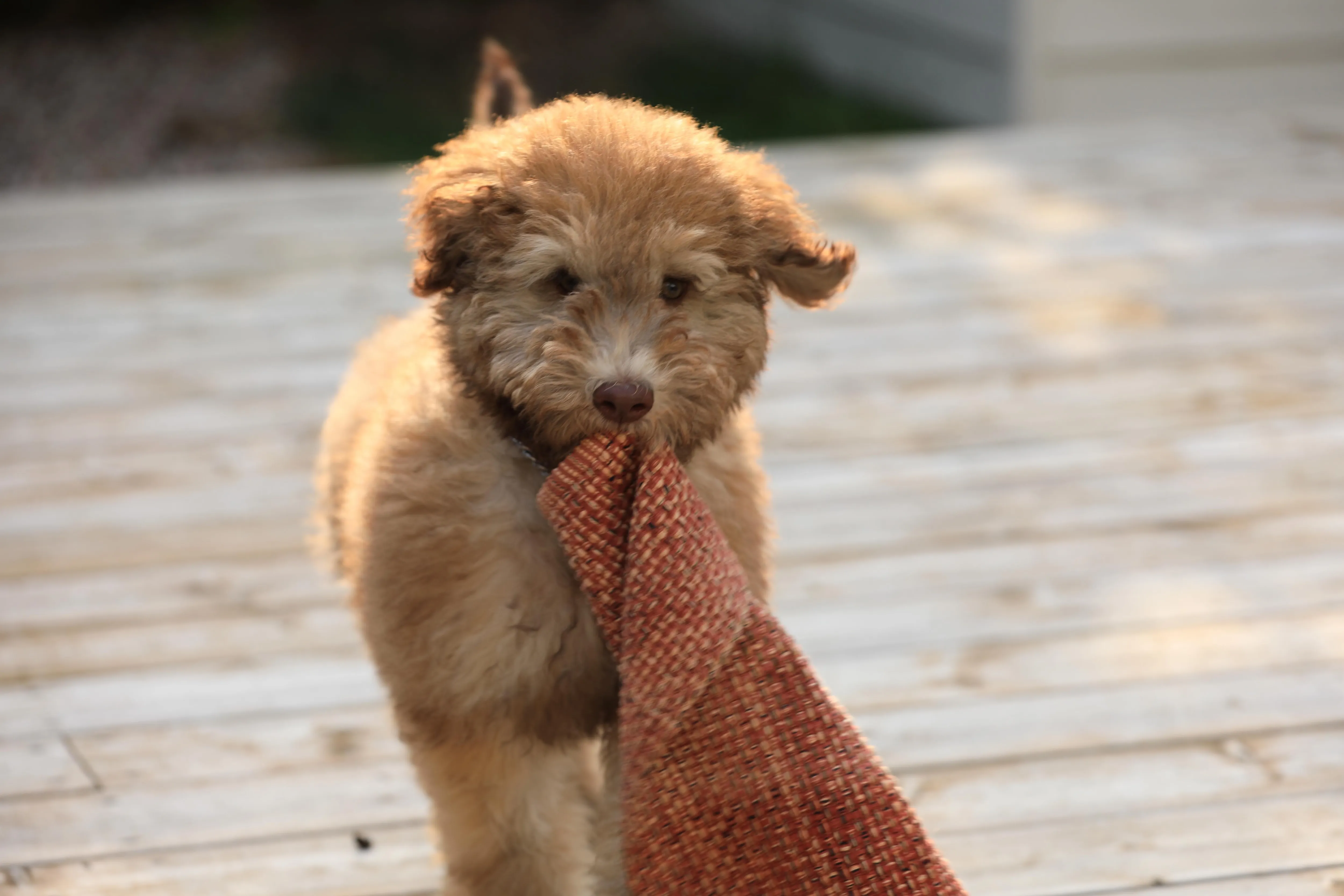 Energetic tan Whoodle puppy dragging a washcloth, a friendly crossbreed that doesn't shed much.
Energetic tan Whoodle puppy dragging a washcloth, a friendly crossbreed that doesn't shed much.
A Whoodle is a cross between a Soft-Coated Wheaten Terrier and a Poodle. This friendly dog inherits the intelligence and affectionate nature from both parent breeds and, significantly, sheds very little. Whoodles are playful and generally good with children, making them great family additions. Their soft, wavy to curly coat requires regular brushing and professional grooming to keep it free of mats.
24. Bernedoodle
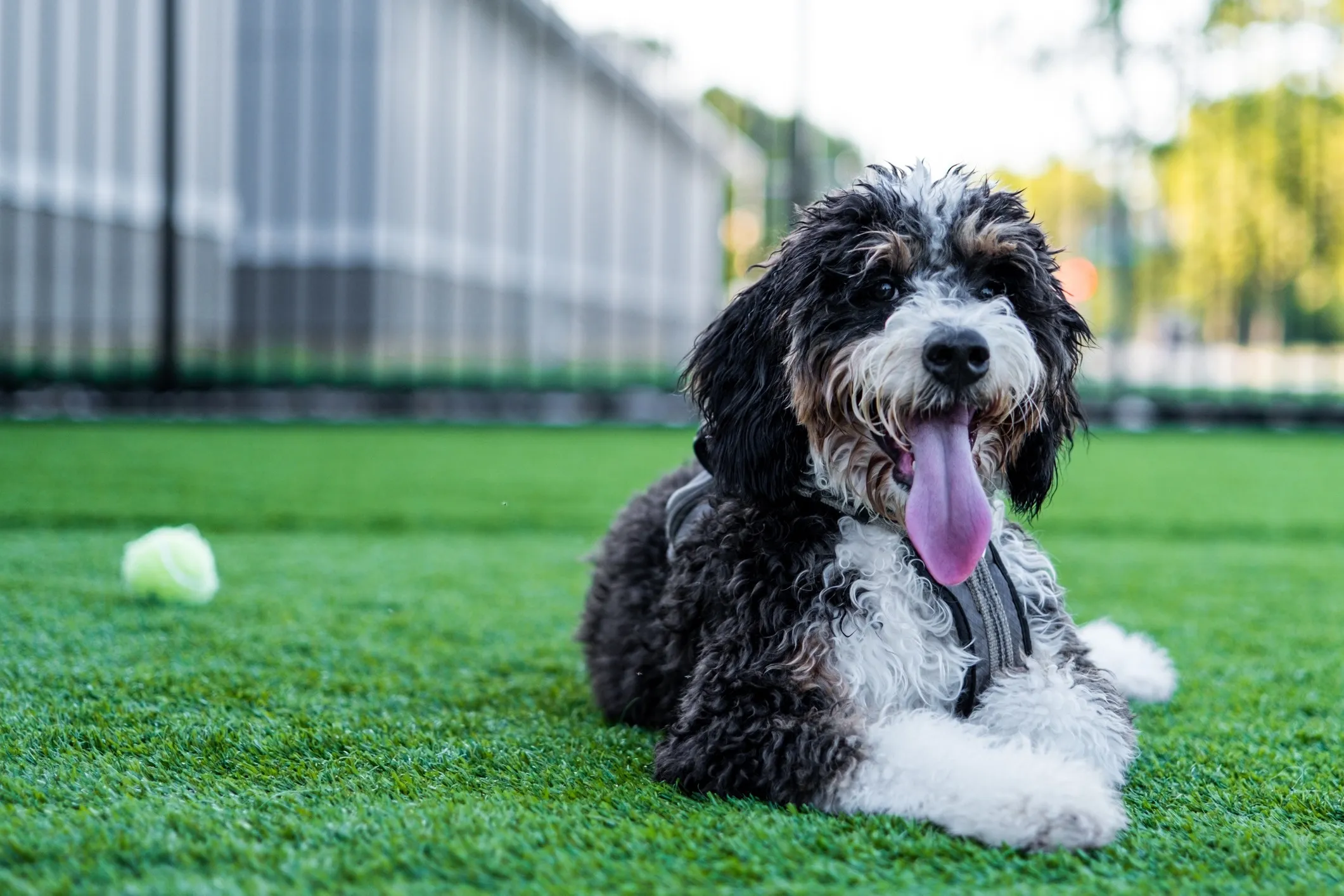 Gentle large Bernedoodle dog lying in grass with his tongue out, a popular low-shedding family dog.
Gentle large Bernedoodle dog lying in grass with his tongue out, a popular low-shedding family dog.
Bernedoodles are a crossbreed resulting from a Bernese Mountain Dog and a Poodle. They are known for their friendly, affectionate nature and gentle demeanor, making them a popular choice for families with children and other pets. While some variation in shedding can occur, most Bernedoodles have low-shedding coats. These large dogs need plenty of exercise to stay active and happy, and their coats require regular grooming to prevent matting.
25. Shorkie
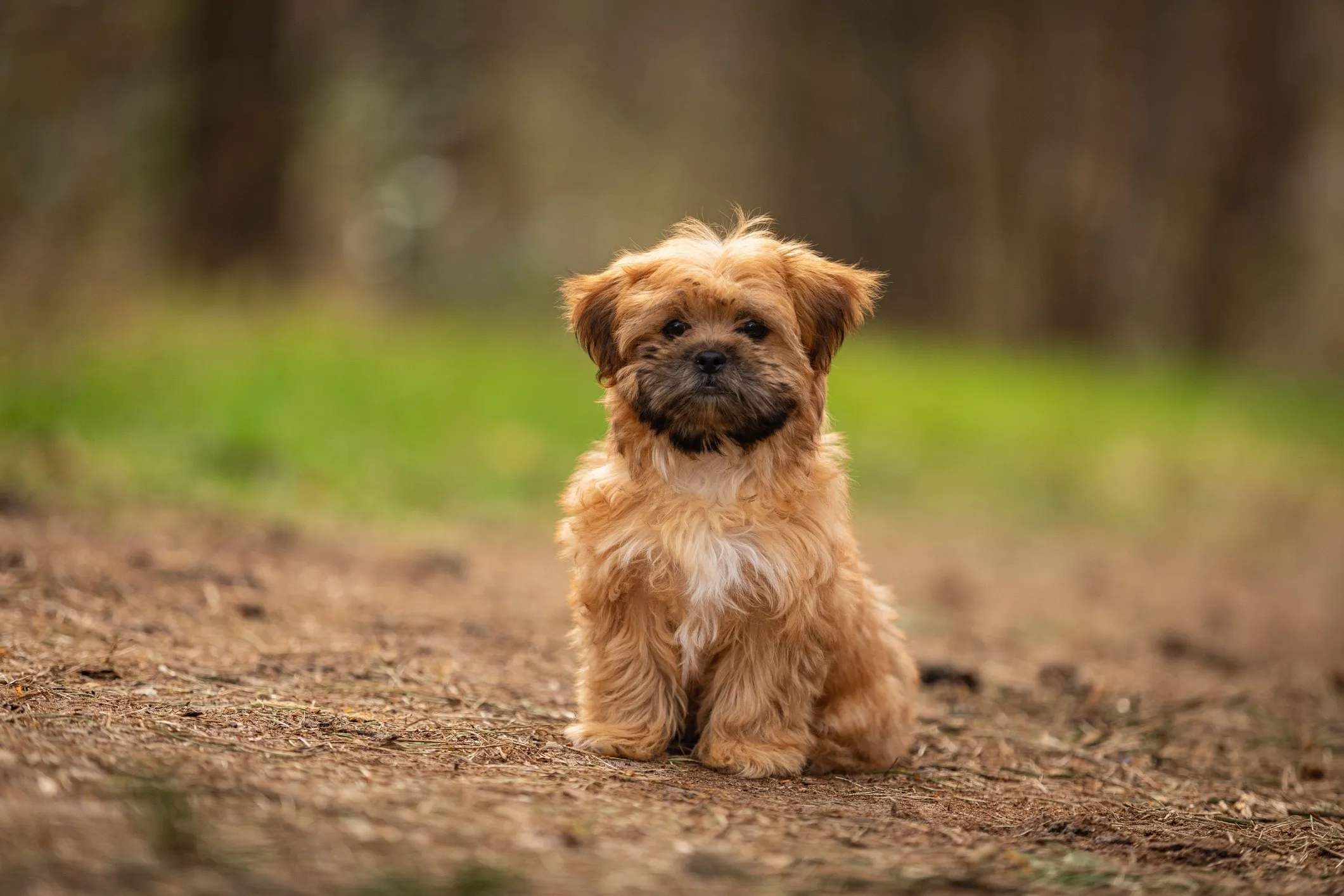 Cute tan and black Shih Tzu and Yorkie mix (Shorkie) sitting on a hiking trail, a small dog who doesn't shed a lot.
Cute tan and black Shih Tzu and Yorkie mix (Shorkie) sitting on a hiking trail, a small dog who doesn't shed a lot.
The Shorkie is a mixed breed combining the best traits of two low-shedding dogs: the Shih Tzu and the Yorkshire Terrier. They are small, playful, and friendly companions who thrive on human interaction. Like their parent breeds, Shorkies require a dedicated and regular grooming routine, including daily brushing to maintain their soft, flowing coats and prevent tangles.
26. Afghan Hound
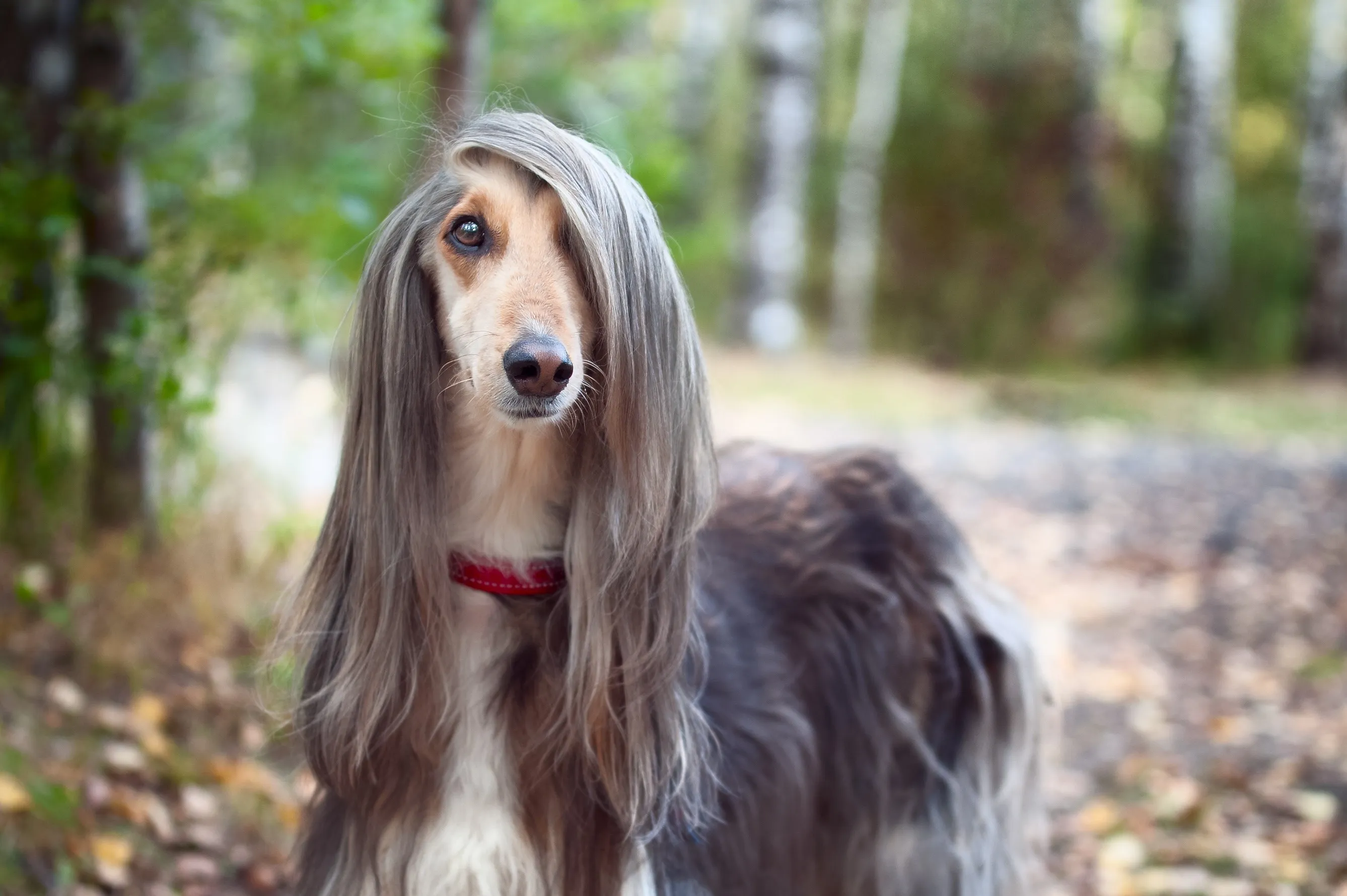 Regal gray and tan Afghan Hound looking at the camera, known for its long, flowing, low-shedding coat.
Regal gray and tan Afghan Hound looking at the camera, known for its long, flowing, low-shedding coat.
Afghan Hounds are renowned for their strikingly long, flowing coats and slender, elegant builds. Despite their voluminous hair, they are surprisingly low-shedding. These sighthounds are built for speed and require significant exercise. While loving toward their families, they can be aloof with strangers, making early and consistent socialization vital for this majestic breed. Their magnificent coat requires extensive daily grooming to prevent matting and keep it pristine.
27. Barbet
 Close-up of a curly red Barbet dog face, highlighting its shaggy, low-shedding coat.
Close-up of a curly red Barbet dog face, highlighting its shaggy, low-shedding coat.
The Barbet, pronounced “bar-bay,” is a cheerful and intelligent water dog with a shaggy, woolly coat that sheds minimally. Their name comes from the French word barbe (beard), a nod to their characteristic hairy chin. Barbets love to swim, and their protective curly coat helps them in water. To keep their coat in good condition, especially after swimming, they need brushing two to three times a week with a slicker or pin brush, along with regular trimming.
28. Shih-Poo
 Sweet tan and black Shih-Poo dog close-up, a small, adaptable mixed breed that doesn't shed much.
Sweet tan and black Shih-Poo dog close-up, a small, adaptable mixed breed that doesn't shed much.
A Shih-Poo is a charming mixed breed, typically a cross between a Shih Tzu and a Toy Poodle. This small pup is adaptable and can thrive in almost any living situation, provided they receive about 30 minutes of daily exercise and regular brushing sessions. Their coat, which can vary in texture, is low-shedding and requires consistent grooming to stay healthy and mat-free.
29. Peruvian Inca Orchid
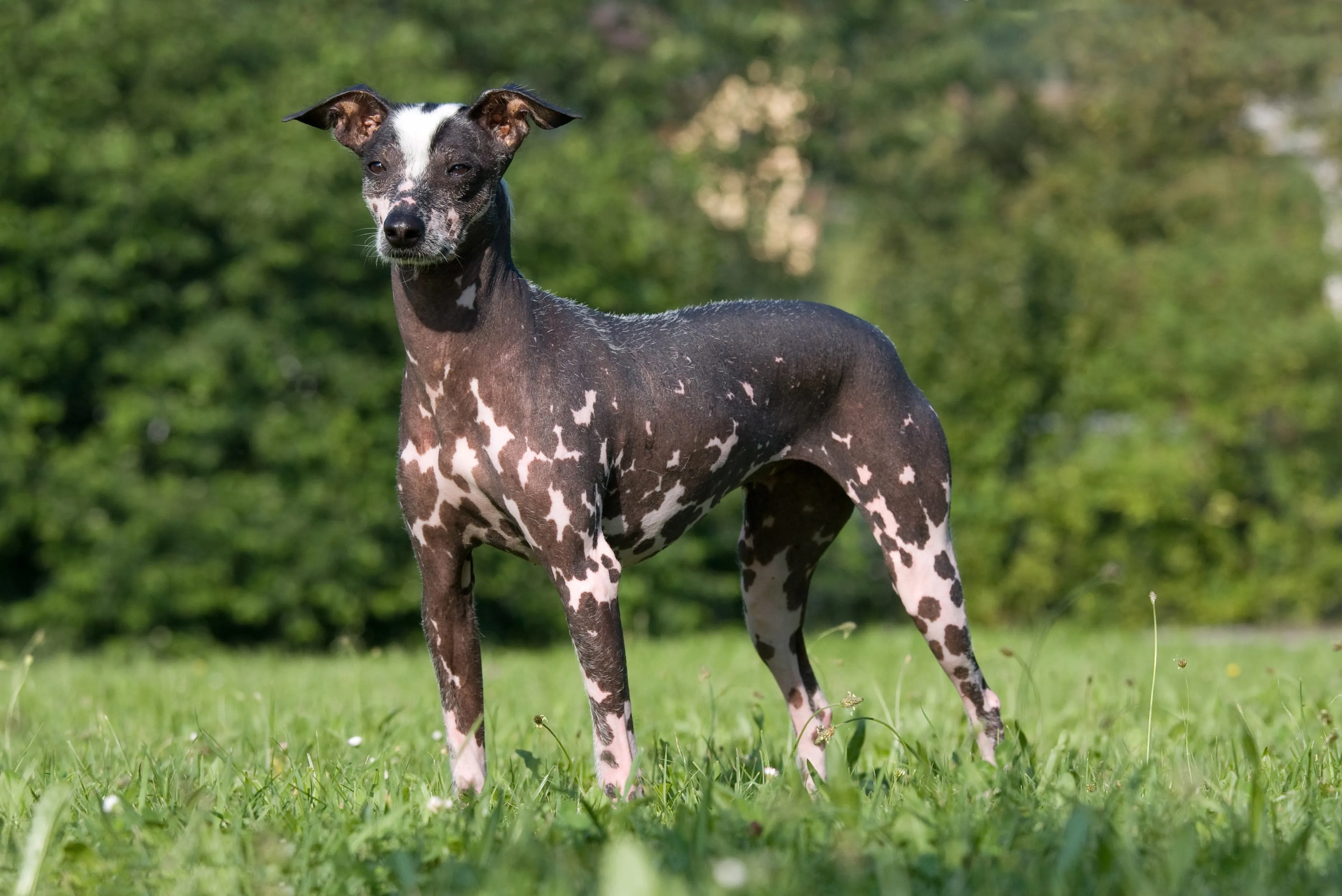 Distinctive Peruvian Inca Orchid dog, an ancient and rare breed known for being truly low-shedding due to its hairless nature.
Distinctive Peruvian Inca Orchid dog, an ancient and rare breed known for being truly low-shedding due to its hairless nature.
Peruvian Inca Orchids are a rare and ancient dog breed, often hairless, which makes them truly low-shedding. They come in three sizes (small, medium, and large) and are the national dog of Peru. While primarily hairless, some may have short, thin coats that also shed minimally. The hairless variety requires special skin care, including protection from sun and cold, while the coated variety needs minimal brushing.
30. Malshi
 Delightful tricolor Malshi dog in green grass, a happy and small low-shedding companion.
Delightful tricolor Malshi dog in green grass, a happy and small low-shedding companion.
The Malshi is a happy and affectionate small mixed breed, a cross between the Maltese and Shih Tzu. They thrive on close companionship and are known for their loving nature. Like their parent breeds, Malshis are low-shedding but require dedication to a regular grooming routine, including daily brushing, to keep their fine coats free of tangles and mats.
Essential Tips for Living with a Low-Shedding Dog
Even with a dog who doesn’t shed a lot, proactive care is crucial for minimizing allergens and maintaining a clean home, especially for allergy sufferers.
Keep Up With Grooming
Regular grooming is paramount for low-shedding breeds. While they don’t shed much, their hair continues to grow and can easily mat, trapping dander and debris.
- Brushing: Daily or every-other-day brushing is often required, depending on the breed and coat type, to remove loose hair and prevent tangles.
- Bathing: Regular bathing (typically every 4-6 weeks) helps to remove dander and dead skin cells from the coat. Using a specialized dander-reducing shampoo can be beneficial.
- Trimming/Stripping: Many low-shedding breeds require professional trimming or hand-stripping every few weeks or months to maintain their coat health and length. Budget for these services or learn how to perform them safely at home.
Maintain a Clean Home Environment
Even with a low-shedding dog, allergens can accumulate. Regular cleaning is essential to create a more allergy-friendly home.
- Vacuuming: Vacuum carpets, rugs, and upholstery frequently, ideally with a vacuum cleaner equipped with a HEPA filter.
- Dusting: Dust surfaces regularly with a damp cloth to capture airborne particles and dander.
- Laundry: Wash pet bedding, blankets, and even your own bedding frequently in hot water.
- Air Purifiers: Consider using air purifiers with HEPA filters in main living areas to capture airborne allergens.
- Ventilation: Keep your home well-ventilated by opening windows when appropriate.
Consult Your Doctor About Allergies
If you or a family member suffers from dog allergies, it’s always best to consult with a healthcare provider. While a low-shedding dog can significantly reduce allergen exposure, it might not eliminate reactions entirely. Your doctor can offer strategies for managing allergies, including medications, nasal sprays, or immunotherapy (allergy shots), to ensure you can comfortably enjoy your canine companion. It’s also wise to avoid direct contact with a dog’s saliva or urine, as these are significant sources of allergens.
Bringing home a dog who doesn’t shed a lot can be a wonderful way for individuals with allergies to experience the profound joy and companionship that pets bring, without the constant struggle of excessive shedding or severe allergic reactions. With careful breed selection and a commitment to consistent grooming and home cleanliness, you can create a harmonious environment for both you and your furry friend.
Conclusion
Choosing a dog who doesn’t shed a lot is an excellent decision for many prospective pet owners, offering the dual benefits of a cleaner home and reduced allergen exposure. While no dog is truly 100% “hypoallergenic,” the breeds listed above significantly minimize the presence of pet hair and dander in your living space. From the intelligent Poodle to the majestic Afghan Hound, a diverse range of sizes, temperaments, and coat types ensures there’s a low-shedding companion suitable for almost any lifestyle. Remember that commitment to regular grooming and a clean environment is key to a happy, healthy relationship with your low-shedding dog. For more detailed information on specific breeds and dog care, explore other valuable resources on Dog Care Story.
Written by: Nicole Zittritsch, LVT, BSc, MPH
